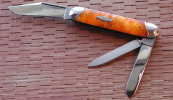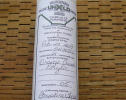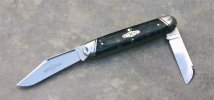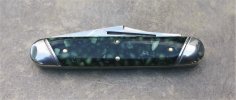Don't forget Orange Crush Perylic




This from the fellow (Bohn I think) that used to run Northwoods before he passed
"Perylic, acrylic and celluloid questions
Every now and then someone emails a question or tells me about a discussion on one of the boards about Great Eastern's Perylic handled knives. Most of the concerns I've heard have surrounded some of the concerns about the problems that have long been associated with some of the old celluloid handled knives. The Cellulloids had a well earned reputation of giving off gases that could interact with other materials as well as shrinking and warping.
I had a good chat with Pat at Great Eastern this morning and have a few answers to some of the concerns. Pat does a lot of research on different types of handle materials and is as knowledgeable about them as anyone I've talked to.
Are the Perylics the same as the Celluloid handles? NO. The Perylics are an acrylic acetate base which form a much harder material that does not contain the suspended gases that can leech off like the celluloid.
Will the Perylics scratch easily? The key word is 'easily'. In short no, BUT, like virtually any handle material, it can scratch and with time and usage will show surface scratches. If you carry your knife on a regular basis in a pocket full of change, keys, etc, in time it will pick up surface scratches. Will it easily dent or chip? No. If you whack it with a hammer, yes.
Can the scratches be buffed out? Yes. The Perylic is a very hard material that can be shaped, sanded and buffed relatively easily. Surface scratches could be cleaned up with a buffing wheel and different grits of buffing compound such as jeweler's rouged.
Pat's going to try and forward a article or two that makes a comparison of the new acrylic/perylics with some of the older materials that might further answer any questions that might be floating around. For now, hope this answers some of your questions."






